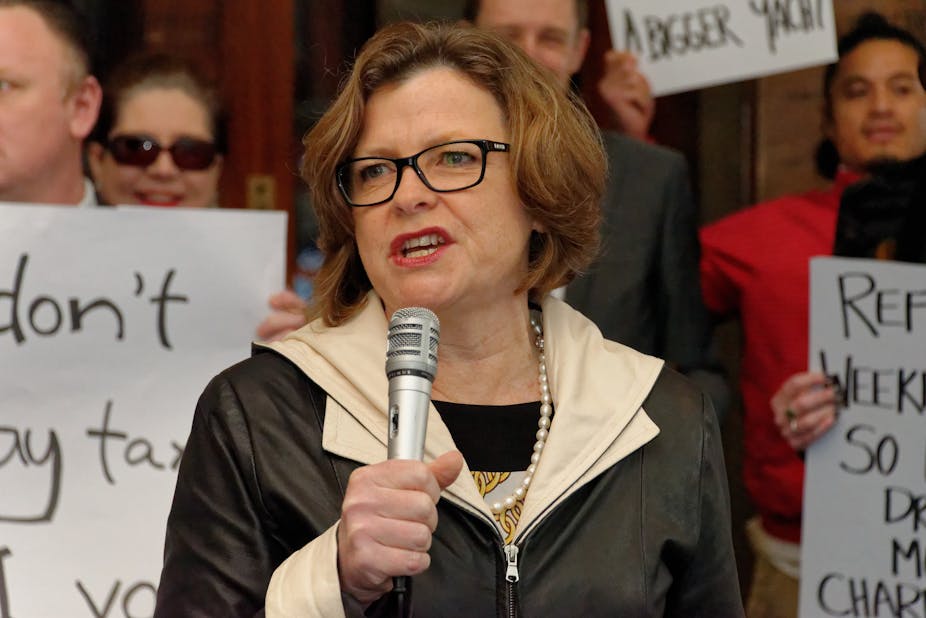If I asked you to picture the typical Australian union member, my guess is that an image of a burly fellow in a hard hat, steel cap boots and stubbies would come to mind. If I then asked you to imagine a unionised workplace, your association may be with building sites or assembly lines.
This is understandable, particularly given the high-rotation media coverage in the past couple of years of machinations within and around key blue-collar unions. It is also in keeping with the longer-run history of trade unionism in Australia where, until reasonably recently, the most highly organised sectors and the most visible and vocal unionists were men hailing from blue-collar workplaces.
These images, however, are out of step with the make-up of trade unions in 2016.
Unions have suffered a catastrophic collapse in membership and union density. The proportion of wage and salary earners who are members has plummeted from its high-water mark of 60% in the immediate post-war years. The most recently released ABS data suggest that just 15% of all Australian employees, and a mere 11% of those employed in the private sector, are members.
Aggregate membership has also been in freefall, and unions now count just 1.7 million people among their ranks.
These changes have been associated with a significant reconfiguration of how men and women are represented within unions. The graph below shows the collapse in membership density during the past two decades. Overall density fell by almost 30 percentage points during this time.

For men the fall was even more stark (43% to 14%). Women’s density fell too, although more steadily and off a lower base (35% to 16%). Women are, as a result, more highly unionised than are their male colleagues for the first time since national union data was collected.
Unionism’s “heartlands” have also changed. Many of the most highly unionised sectors, like education and training, and occupations such as nurses and midwives are feminised. Industries where union membership has trended upward over the past decade are feminised (such as social welfare and assistance).
Whereas 20 years ago there was a 60/40 split in male membership of unions, women now represent slightly under 50% of all members. I will not be surprised to see female membership overtake men’s on the next ABS data.
When I began my PhD research in the mid-1990s, women were typically referred to in the international and Australian academic literature as “marginal trade unionists” and considered hard to organise. So, the status of this group – along with “young people” and “casuals” – was cited as a key reason for membership decline.
But the changes in membership density and in membership share suggest that, if it ever was the case, women are no more “marginal” as union members than their male colleagues.
My research suggest that there is a mismatch between these significant changes and the leadership, culture and “business” of unions. There is a clear gendered hierarchy, not dissimilar to that seen in organisations in the private and public sector within unions.
Despite being roughly half of all union members, and taking an even larger share of (unpaid) union delegate or representative roles in unionised workplaces, significant gaps emerge in women’s representation in more senior and strategic roles. For example, on 2015 Australian Council of Trade Unions data, 38.5% of union secretaries – the most senior and powerful leaders within the movement – are women.
Women’s representation in these roles has grown during the past 15 years – for example, just 23% of secretaries were women in 1999 – but the dial has moved considerably less than in relation to women’s share of union membership.
My 2012 study of female paid officials of unions suggested that, despite high levels of commitment to union work and enjoyment of many aspects of the job, women working within the union movement keenly felt they were under-represented in senior roles.
Additionally, women reported sexism and a “masculinist” culture as being alive and well within their union workplaces. This culture, they believed, had a strong impact on union “business” such as collective bargaining and other industrial agendas. In particular, they reported that issues perceived as “women’s issues” (pay equity, work and care, discrimination) were marginalised from what were framed as true “industrial”, and therefore important, union issues.
Women are now well and truly in the mainstream, not at the margins, of union membership. The challenge for unions, in the context of a significantly gendered reconfiguration of union membership, is to make themselves more relevant to their new heartland.
You can read other pieces in the series here.

